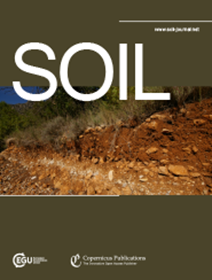评估有覆盖作物的温带农田N2O排放和碳固存:来自田间试验的见解
IF 4.3
2区 农林科学
Q1 SOIL SCIENCE
引用次数: 0
摘要
摘要。覆盖作物(CCs)通过帮助碳(C)固存和减少收获后土壤矿质氮(SMN)的损失,增强了农业实践的环境可持续性。然而,它们对一氧化二氮(N2O)排放(一种强效温室气体)的影响提出了一个复杂的挑战,不同研究的结果各不相同。本研究旨在阐明不同的冬季碳汇——冬季黑麦(抗冻草)、赛燕麦(抗冻草)和春野豌豆(抗冻豆科)——与裸休耕对照对SMN动态、N2O排放和碳固存的影响。这些影响是通过测量SMN动态和N2O排放在田间试验中确定的。利用土壤有机碳(SOC)模型,利用实测的地上和地下碳生物量,预测了50 a期间碳对土壤碳固存的影响。虽然CCs在生长过程中有效地降低了SMN水平,但与裸休耕相比,它们略微增加了N2O排放。特别是,冬季霜冻事件引发了对霜冻敏感的品种的大量排放。此外,在所有CC处理中,残茬掺入和耕作方式与N2O排放量增加有关。冬麦生物量产量和氮素吸收量高,累积N2O排放最高,凸显了生物量管理和耕作方式对N循环和N2O排放的影响。在整个试验期(18个月),与休耕(2.6±1.7 kgn20 - nha -1)相比,CC处理导致黑麦、燕麦和野豌豆的N2O直接排放量(分别为4.5±3.0、2.7±1.4和3.1±3.8 kgn20 - nha -1)略有增加。然而,与休耕相比,非豆科植物碳汇减少N2O间接排放的潜力(黑麦和燕麦分别为0.3±0.4和0.2±0.1 kgn20 - nha -1a-1)及其对碳封存的贡献(每四年种植一次碳汇,50年期间为120-150 kgCha-1a-1)可能会部分抵消这些排放。因此,虽然CCs提供了环境效益,但其对N2O排放的净影响需要进一步研究针对特定场地条件的优化CC选择和管理策略,以充分发挥其环境优势。本文章由计算机程序翻译,如有差异,请以英文原文为准。
Evaluating N2O emissions and carbon sequestration in temperate croplands with cover crops: insights from field trials
Abstract. Cover crops (CCs) are acclaimed for enhancing the environmental sustainability of agricultural practices by aiding in carbon (C) sequestration and reducing losses of soil mineral nitrogen (SMN) after harvest. Yet, their influence on nitrous oxide (N2O) emissions – a potent greenhouse gas – presents a complex challenge, with findings varying across different studies. This research aimed to elucidate the effects of various winter CCs – winter rye (frost-tolerant grass), saia oat (frost-sensitive grass), and spring vetch (frost-sensitive legume) – compared to a bare fallow control on SMN dynamics, N2O emissions, and C sequestration. These effects were determined by measuring SMN dynamics and N2O emissions in field experiments. The effects of CCs on soil C sequestration over a 50-year period were predicted by soil organic C (SOC) models using measured aboveground and belowground CC biomass. While CCs efficiently lowered SMN levels during their growth, they slightly increased N2O emissions compared to bare fallow. In particular, winter frost events triggered significant emissions from the frost-sensitive varieties. Moreover, residue incorporation and tillage practices were associated with increased N2O emissions in all CC treatments. Winter rye, characterized by its high biomass production and nitrogen (N) uptake, was associated with the highest cumulative N2O emissions, highlighting the influence of biomass management and tillage practices on N cycling and N2O emissions. The CC treatment resulted in a slight increase in direct N2O emissions (4.5±3.0, 2.7±1.4, and 3.1±3.8kgN2O-Nha-1 for rye, oat, and vetch, respectively) compared to the fallow (2.6±1.7kgN2O-Nha-1) over the entire trial period (18 months). However, the potential of non-legume CCs to reduce indirect N2O emissions compared to fallow (0.3±0.4 and 0.2±0.1kgN2O-Nha-1a-1 for rye and oat, respectively) and their contribution to C sequestration (120–150 kgCha-1a-1 over a period of 50 years when CCs were grown every fourth year) might partially counterbalance these emissions. Thus, while CCs provide environmental benefits, their net impact on N2O emissions requires further research into optimized CC selection and management strategies tailored to specific site conditions to fully exploit their environmental advantages.
求助全文
通过发布文献求助,成功后即可免费获取论文全文。
去求助
来源期刊

Soil
Agricultural and Biological Sciences-Soil Science
CiteScore
10.80
自引率
2.90%
发文量
44
审稿时长
30 weeks
期刊介绍:
SOIL is an international scientific journal dedicated to the publication and discussion of high-quality research in the field of soil system sciences.
SOIL is at the interface between the atmosphere, lithosphere, hydrosphere, and biosphere. SOIL publishes scientific research that contributes to understanding the soil system and its interaction with humans and the entire Earth system. The scope of the journal includes all topics that fall within the study of soil science as a discipline, with an emphasis on studies that integrate soil science with other sciences (hydrology, agronomy, socio-economics, health sciences, atmospheric sciences, etc.).
 求助内容:
求助内容: 应助结果提醒方式:
应助结果提醒方式:


